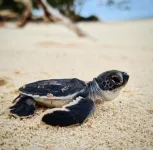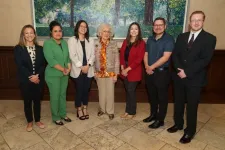(Press-News.org) New research suggests that green turtle hatchlings ‘swim' to the surface of the sand, rather than ‘dig’, in the period between hatching and emergence. The findings have important implications for conserving a declining turtle population globally.
Published today in Proceedings B, scientists from UNSW’s School of Biological, Earth and Environmental Sciences, used a small device, known as an accelerometer, to uncover novel findings into the behaviours of hatchlings as they emerge from their nests.
Sea turtle eggs are buried in nests 30 – 80cm deep. Once hatched, the newborn turtles make their way to the surface of the sand over three to seven days. But because this all happens underground, we have very little understanding of the first few days of a hatchling’s life.
The results provided through this novel method revealed that buried hatchlings maintained a head-up orientation and unexpectedly, moved vertically through the sand by rocking forwards and backwards rather than tipping side-to-side as expected with digging.
“When I visualise a hatchling that has just come out of its egg, it is completely in the dark in its surroundings. There’s no sign to point which way is up toward the surface – yet, they will orientate themselves and move upwards regardless,” says Mr Davey Dor, who led the study as part of his PhD. “Our initial findings and 'proof' of this new methodology opens the door for so many new questions in sea turtle ecology.”
How can you study something underground?
The image of newly hatched baby turtles moving enthusiastically across the sand and into the ocean is somewhat familiar. But what happens before then?
Once they emerge from their eggs, hatchlings move through the sand column and eventually emerge on the surface.
“It was about 64 years ago that the period of turtles hatching from their eggs and coming up to the surface was first observed,” says Mr Dor. “And since then, people have tried different techniques to observe this phase, such as using a glass viewing pane to watch the hatchlings, or using microphones to listen to their movement.”
Each of these previous techniques has come with limitations which means it has remained difficult to study the first few days of life for turtle hatchlings. “You just don't think about how much work it takes for these tiny hatchlings to swim through the sand in the dark, with almost no oxygen,” says Associate Professor Lisa Schwanz. "It happens right under everyone’s feet, but we haven’t had the technology to really understand what is happening during this time.”
So Mr Dor, A/Prof. Lisa Schwanz and Dr. David Booth, from the University of Queensland, set out to explore new ways to observe and research this obscure, little-known process.
Miniature accelerometer backpacks
Accelerometers, which measure changes in speed or direction, have previously been used to study animal movement, behaviours and physiology.
“The simple principle of the type of accelerometer we used is that it measures acceleration from three different angles,” says Mr Dor. “So it can measure a change in velocity in a forwards and backwards motion, an up and down motion and a side to side motion.”
But until now, an accelerometer hadn’t been used in this context.
This research took place on Heron Island, a long-term monitoring nesting site for green turtles in the southern Great Barrier Reef, where nesting season typically runs from December to March.
"After locating the nests, we waited for approximately 60 days for the eggs to develop,” says Mr Dor. “Three days before they hatched, we put a device called a hatch detector next to 10 different nests. This unique instrument measures voltage at the nest site and lets us know when the hatchlings had hatched out of their eggs.”
As soon as the team became aware that the eggs had hatched, they carefully dug down into the nest, selected the hatchling closest to the surface and attached a light-weight, miniature accelerometer onto the baby turtle, before placing it back. “We then gently layered the sand back in the way it was found,” says Mr Dor.
It was then a waiting game to see when the hatchlings emerged. “We checked the nest site every three hours and when they did finally emerge, we retrieved the accelerometer from the hatchling carrying it.”
The accelerometer provided new data on the direction, speed and time it took for the ten hatchlings to emerge. “We analysed the data and found that hatchlings show amazingly consistent head-up orientation – despite being in the complete dark, surrounded by sand,” says Mr Dor. “We found that their movement and resting periods are generally quite short, that they move as if they were swimming rather than digging, and that as they approach the surface of the sand, they restrict their movement to nighttime,” says Mr Dor.
Conservation and nest intervention
Sea turtle populations are in decline in many parts of the world, with several species listed as endangered. The nesting phase is a major vulnerability for turtle populations and as a result, conservation management often focuses on nest intervention, including relocation, shading and watering.
Nest relocation has been used widely around the world for many years and the practice is expected to continue as the effects of climate change and rising sea levels are affecting turtle nesting. However, factors such as moisture and temperatures in the nest, which can vary when a nest is moved, can impact important performance traits of hatchlings, including their speed and movement.
“Altering nest characteristics, such as substrate moisture and depth, could have consequences for hatchlings that we currently don’t understand,” says Mr Dor. “This means knowledge of hatchling behaviour in the sand column – and its links to offspring success – is key to future conservation practices.”
While we know that in the scramble across the sand to the water, hatchlings are at great risk from predators, “it’s also true that some hatchlings don’t even make it to that point,” says A/Prof. Schwanz. “We have so little knowledge of what makes one hatchling successfully emerge while another doesn’t, so it's really important that we figure out what might contribute to this.”
Opening the door to further research
The latest publication confirms that using accelerometers to monitor hatchlings provides many benefits, including data of movement and behaviours, and crucially, the ability to study turtles when our visibility of them is limited.
These findings have also provided new insights and changed previous assumptions about hatchlings' earliest days in the sand.
“There are lots of factors that we don't really understand because we haven't been able to observe this stage of their lives, but we hope this will change as a result of this new method, particularly in answering questions about best conservation practices,” says Mr Dor.
The following summer, Mr Dor returned to Heron Island to put accelerometers on multiple hatchlings in a single nest. “So using the next year's data, we'll get a sense of how coordinated the nests are, because there is a theory about whether the turtles coordinate their movements, or if they have a division of labour,” says A/Prof. Schwanz.
END
Scientists use tiny ‘backpacks’ on turtle hatchlings to observe their movements
2024-10-02
ELSE PRESS RELEASES FROM THIS DATE:
Snakes in the city: Ten years of wildlife rescues reveal insights into human-reptile interactions
2024-10-02
A new analysis of a decade-long collection of wildlife rescue records in NSW has delivered new insights into how humans and reptiles interact in urban environments.
Researchers from Macquarie University worked with scientists from Charles Darwin University, and the NSW Department of Climate Change, Energy, the Environment and Water to analyse over 37,000 records of snake and lizard rescues in the Greater Sydney region between 2011 and 2021.
Their study, Interactions between reptiles and people: a perspective from wildlife rehabilitation records is published in the journal Royal Society Open Science on Wednesday 2 October.
Lead author Teagan Pyne, ...
Costs of fatal falls among US older adults trump those attributed to firearm deaths
2024-10-01
The cost of fatal falls among older people (45-85+) trump those of firearm deaths in the US, finds research published in the open access journal Trauma Surgery & Acute Care Open.
The stark economics and shifting age demographics in the US underscore the urgency of preventive measures, conclude the researchers.
Falls account for around 1 in 5 of all injury-related hospital admissions, and the World Health Organization reports that falls are the second leading cause of unintentional injury deaths worldwide, with the over 65s especially vulnerable, highlight the researchers.
Like falls, firearms related injuries ...
Harmful diagnostic errors may occur in 1 in every 14 general medical hospital patients
2024-10-01
Harmful diagnostic errors may be occurring in as many as 1 in every 14 (7%) hospital patients—at least those receiving general medical care—suggest the findings of a single centre study in the US, published online in the journal BMJ Quality & Safety.
Most (85%) of these errors are likely preventable and underscore the need for new approaches to improving surveillance to avoid these mistakes from happening in the first place, say the researchers.
Previously published reports suggest that current trigger tools for ...
Closer look at New Jersey earthquake rupture could explain shaking reports
2024-10-01
The magnitude 4.8 Tewksbury earthquake surprised millions of people on the U.S. East Coast who felt the shaking from this largest instrumentally recorded earthquake in New Jersey since 1900.
But researchers noted something else unusual about the earthquake: why did so many people 40 miles away in New York City report strong shaking, while damage near the earthquake’s epicenter appeared minimal?
In a paper published in The Seismic Record, YoungHee Kim of Seoul National University and colleagues show how the earthquake’s ...
Researchers illuminate inner workings of new-age soft semiconductors
2024-10-01
One of the more promising classes of materials for next-generation batteries and electronic devices are the organic mixed ionic-electronic conductors, OMIECs for short. These soft, flexible polymer semiconductors have promising electrochemical qualities, but little is known about their molecular microstructure and how electrons move through them – an important knowledge gap that will need to be addressed to bring OMIECs to market.
To fill that void, materials scientists at Stanford recently employed ...
University of Houston partners with Harris County to create a sustainable energy future
2024-10-01
University of Houston researchers are partnering with the Harris County Office of County Administration’s Sustainability Office, the Harris County Energy Management Team and other county staff to develop a comprehensive baseline of energy use and energy-use intensity for county’s assets. Once established, the baseline will enable the team to track progress and evaluate the effectiveness of energy-saving measures over time, laying the groundwork for programs aimed at reducing energy consumption, maximizing savings, and increasing the use of renewable and resilient ...
Looking deeper into the mirror
2024-10-01
A team of Canadian and American scientists has made a promising breakthrough in understanding the origins of a mysterious neurological disorder known as mirror movements.
The discovery was made by Kaiyue Zhang, a doctoral student at the Montreal Clinical Research Institute (IRCM), affiliated with Université de Montréal, and by Karina Chaudhari, a doctoral student at the University of Pennsylvania.
As co-first authors, they published their study today in the journal Science Signaling.
They were led by Frédéric Charron, an UdeM research professor ...
Friends of BrainHealth donor circle awards coveted grants to fuel innovative research
2024-10-01
The 2024 Ramona Jones Friends of BrainHealth Luncheon on September 30, 2024 continued the 25th anniversary celebration of Center for BrainHealth – part of The University of Texas at Dallas – and the second year this annual event has been sponsored by founding Advisory Board member Ramona Jones and her family.
Staged “Shark Tank”-style” at the Dallas Country Club, the event featured a competition between emerging scientists pitching novel research proposals and vying for $20,000 in seed funding. Event co-chair Nikki Kapioltas opened the event, calling attention to a milestone ...
Study of infertility, health among women of Mexican heritage funded by $2.2M NIH grant
2024-10-01
Researchers at the University of Arizona Health Sciences and the Instituto Nacional de Salud Pública in Mexico are using a $2.2 million National Institutes of Health grant to explore the link between infertility and long-term health issues among Hispanic women of Mexican heritage.
According to recent research, female infertility is often associated with greater risks of cancer, cardiovascular disease and premature mortality. Hispanic women are up to 70% more likely to experience infertility than white women, yet little is known about their long-term health.
“Hispanics are the largest minority group in the United States, and 60% of Hispanics have Mexican heritage. ...
Airborne plastic chemical levels shock researchers
2024-10-01
A new study documents how Southern Californians are chronically being exposed to toxic airborne chemicals called plasticizers, including one that’s been banned from children’s items and beauty products.
Plasticizers are chemical compounds that make materials more flexible. They are used in a wide variety of products ranging from lunchboxes and shower curtains to garden hoses and upholstery.
“It’s not just for drinking straws and grocery bags,” said David Volz, environmental sciences professor at UC Riverside, ...




